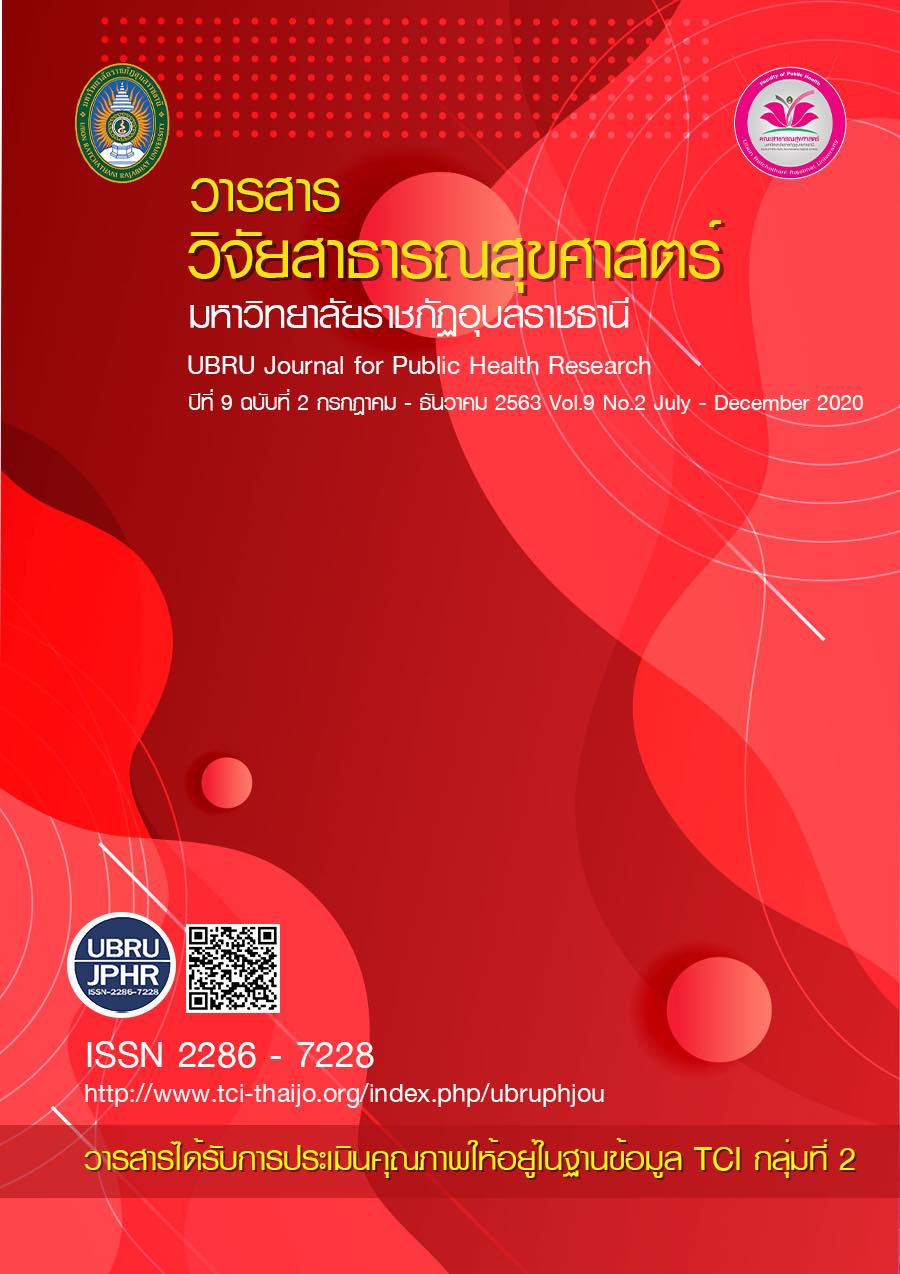The effects of self-regulation theory based oral health care program on oral health behavior in elderly in Wang Yang subdistrict, Wang Yang district, Nakhon Phanom province
Keywords:
Oral Health Care, Elderly, Self-Regulation TheoryAbstract
The purpose of this quasi-experimental research was designed to the effects of oral health care program applying self-regulation theory on change dental care behaviors of the elderly in Wang Yang Subdistrict, Wang Yang District, Nakhon Phanom Province. The samples were 66 and were divided into two groups, 33 elderly in the experimental group and 33 elderly in the control group. The duration of implementation were 8 weeks.The experimental group received the effects of oral health care program applying self-regulation theory consisted of 1)self-observation 2)self-judgment 3)self-reaction and the control group received routine care only.The instruments employed in the study included the demographic data questionnaire,5 Self-efficacy expectations in the result of self-practice and self-practice in changing teeth care behavior data were collected after the experiment in week 8, analyzed by using descriptive statistics. And inferential statistics, statistics for testing the difference of mean scores by statistics Paired Sample t-test and Independent Sample t-test.
The results of this study ware as follows: After receiving the experimental group mean scores of self-efficacy of the oral health care, expectation of dental health care and self-practice in behavior modification dental care more than before the experiment with statistical significant at .05 level
After receiving the experimental group had less amount of plaque than before. Participation in the program and less than that the control group with statistical significant at .05 level
References
กรรณิกา เรืองเดช ชาวสวนศรีเจริญ และคณะ. (2561). ปัจจัยทำนายพฤติกรรมการดูแลสุขภาพช่องปากของผู้สูงอายุในโครงการฟันเทียม พระราชทานของโรงพยาบาลวังวิเศษ จังหวัดตรัง. วารสารเครือข่ายวิทยาลัยพยาบาลและการสาธารณสุขภาคใต้. 5(3), 151–163.
กองทันตสาธารณสุข กรมอนามัย กระทรวงสาธารณสุข. (2547). คู่มือการดูแลสุขภาพช่องปากของตนเอง และครอบครัวในงานทันตกรรมป้องกัน. กรุงเทพฯ: โรงพิมพ์องค์การทหารผ่านศึก.
ขนิษฐา จำปาสิม. (2556). ผลของโปรแกรมทันตสุขศึกษาเพื่อการส่งเสริมการดูแลรักษาฟันปลอมทั้งปากของผู้สูงอายุ อำเภอแวงน้อย จังหวัดขอนแก่น. วารสารทันตาภิบาล. 24(2), 10–18.
จงกลนี บุญอาษา และพรทิพย์ คำพอ. (2557). การพัฒนาศักยภาพการดูแลสุขภาพช่องปากของผู้สูงอายุ หมู่ 13 ตำบลบัวใหญ่ อำเภอน้ำพอง จังหวัดขอนแก่น. วารสารวิจัยและพัฒนาระบบสุขภาพ. 6(3), 1–10.
จังหวัดนครพนม. (2561). ข้อมูลประชากรกลางปี สารสนเทศภูมิศาสตร์ข้อมูลสุขภาพ จังหวัดนครพนม.นครพนม: จังหวัดนครพนม.
ชมัยพร วรรณปักษ์. (2561). ผลของโปรแกรมส่งเสริมพฤติกรรมสุขภาพของผู้สูงอายุในหมู่บ้านโคกสะอาด ตำบลสีคิ้ว อำเภอสีคิ้ว จังหวัดนครราชสีมา. วารสารศูนย์อนามัยที่ 9. 12(27), 5–22.
ณัฐวุฒิ พูลทอง, สมศักดิ์ อาภาศรีทองกุล และสุพัตรา วัฒนเสน. (2559). การพัฒนาระบบการดูแลสุขภาพช่องปากผู้สูงอายุโดยเครือข่ายชุมชนบ้านโนนสง่า ตำบลซาง อำเภอเซกา จังหวัดบึงกาฬ. วารสารทันตาภิบาล. 27(2), 53–67.
บรรลุ ศิริพานิช. (2542). ผู้สูงอายุไทย: ความเปลี่ยนแปลงของร่างกายและการท้างานของร่างกายเมื่อเข้าสู่วัยสูงอายุ. พิมพ์ครั้งที่ 2. กรุงเทพฯ: พิมพ์ดี.
ประคอง อินทรสมบัติ. (2539). การประเมินภาวะสุขภาพในผู้สูงอาย.กรุงเทพฯ: รามาธิบดีพยาบาลสาร.
ประเวศ วะสี. (2543). ยุทธศาสตร์ทางปัญญาและการปฏิรูปการศึกษาที่พาประเทศพนวิกฤต.กรุงเทพฯ: พริกหวานกราฟ.ฝ่ายทันตสาธารณสุข โรงพยาบาลวังยาง. (2561). ฝ่ายทันตสาธารณสุข โรงพยาบาลวังยาง. [ออนไลน์]. ได้จาก: http://www.wangyanghos.go.th/webthathos/[สืบค้นเมื่อวันที่ 15 มีนาคม 2561].
ราชบัณฑิตยสถาน. (2542). พจนากรุมฉบับราชบัณฑิตยสถาน พ.ศ. 2542. กรุงเทพฯ: โรงพิมพ์คุรุสภาลาดพร้าว.
วิไลวรรณ ทองเจริญ. (2548). สุขภาพ: สตรีสูงอายุ. วารสารพฤฒาวิทยาและเวชศาสตร์ผู้สูงอายุ. 6(3), 43–48.
สมโภชน์ เอี่ยมสุภาษิต. (2549). ทฤษฎีและเทคนิคการปรับพฤติกรรม (Theories and Techniques in Behavior modification). พิมพ์ครั้งที่ 6. กรุงเทพฯ: จุฬาลงกรณ์มหาวิทยาลัย.
สมศักดิ์ ศรีสันติสุข. (2539). สังคมวิทยาภาวะสูงอายุ: ความเป็นจริงและการคาดการณ์ในสังคมไทย.กรุงเทพฯ: จุฬาลงกรณ์มหาวิทยาลัย.
เสาวนีย์ โสบุญ. (2560). รูปแบบการสร้างเสริมความรู้สึกมีคุณค่าในตนเองของผู้สูงอายุโดยการมีส่วนร่วมของชุมชนกรณีศึกษาพื้นที่เทศบาลตำบลตาดทอง อำเภอเมือง จังหวัดยโสธร. วารสารวิจัยสาธารณสุขศาสตร์ มหาวิทยาลัยราชภัฏอุบลราชธานี. 6(2),43-54, บทความวิจัย
สำนักทันตสาธารณสุข กรมอนามัย. (2561). สำรวจสุขภาพช่องปากแห่งชาติ ครั้งที่ 8.กรุงเทพฯ:กรมอนามัย กระทรวงสาธารณสุข.
สุเทียน แก้วมะคำ และอารีย์ แก้วมะคำ. (2561). คุณภาพชีวิตในมิติสุขภาพช่องปากของผู้สูงอายุติดบ้านในอำเภอเชียงของ จังหวัดเชียงราย. เชียงรายเวชสาร. 10(1), 37–47.
อรุณ จิรวัฒน์กุล. (2551). ชีวสถิติสำหรับงานวิจัยทางวิทยาศาสตร์สุขภาพ.ขอนแก่น: ภาควิชาชีวสถิติ คณะสาธารณสุขศาสตร์ มหาวิทยาลัยขอนแก่น.
อังศินันท์ อินทรกำแหง. (2552). การปรับเปลี่ยนพฤติกรรมสุขภาพ.กรุงเทพฯ: บริษัทสุขุมวิทการพิมพ์.
ฤทธิชัย แกมนาค และสุภัชชา พันเลิศพาณิชย์. (2559).รูปแบบการมีส่วนร่วมในการสร้างเสริมสุขภาพผู้สูงอายุของโรงเรียนผู้สูงอายุวัดหัวฝาย ตำบลสันกลาง อำเภอพาน จังหวัดเชียงราย. ฉบับพิเศษ ปีที่ 11 สิงหาคม 2559 (สหวิทยาการด้านมนุษย์ศาสตร์และสังคมศาสตร์ มหาวิทยาลัยราชภัฏอุบลราชธานี) 33(2) Research Articles
Asawaworarit, N. et al. (2003). Tooth Wear Part I: Prevalence and Etiology. J Dent Assoc Thai, 53(4), 276-85.
Best, J. W. (1977).Research in Education.3rd ed. Englewood Cliffs, New Jersey: Prentice Hall, Inc.
Brodeur, JM. et al. (1993). Nutrient Intake and Gastrointestinal Disorders Related to Masticatory Performance in the Edentulous Elderly. J Prosthet Dent, 70(5), 468-473.
Creer,TL.(2000). Self-management,Handbook of Self-Regulation. Sandiago: Academic Press.
Edmomson, EMS. (1990). Food Composition and Food Cariogenicity Factors Affecting the Cariogenic Potential of Food. Caries Res, 24, 60-71.
Griffiths, J. and Boyte, S. (1993). Aids to Oral Self-care, Rehabilitation and Independence Clinical skills series: Guide to Holistics Oral Care a Practical Approach. Professional Nurse Mosby, 112-125.
Husen, T. and Postlethwaite, N. T. (1994). The International Encyclopedia of Education. 7th ed.). Great Britain: BPC Wheatons.
Joshi, A. et al. (1993). Root Caries Incidence and Associated Risk Factor in Middle–Aged and Older Adults. Gerdontal, 10, 83 –89.
Kanfer, F. H. and Gaelick, L. (1991). Self-management Method. In F. H. Kanfer, & A.P. Goldstein.(Eds.). Helping People Change. New York: Pergamon.
Locker, D. andLeake, JL. (1993). Risk Indicators and Risk Markers for Periodontal Disease Experience in Older Adult living Independently in Ontario, Canada. J Dent Res, 72, 9–17.
Meiner, R.G. (2006). Fatigue and Therapeutic Exercise. Journal of the Neurological Sciences, 242(1–2), 37–41.
Downloads
Published
How to Cite
Issue
Section
License
Copyright (c) 2020 คณะสาธารณสุขศาสตร์ มหาวิทยาลัยราชภัฏอุบลราชธานี

This work is licensed under a Creative Commons Attribution-NonCommercial-NoDerivatives 4.0 International License.
เนื้อหาและข้อมูลในบทความที่ลงตีพิมพ์ในวารสารวารสารวิจัยสาธารณสุขศาสตร์ มหาวิทยาลัยราชภัฏอุบลราชธานี ถือเป็นข้อคิดเห็นและความรับผิดชอบของผู้เขียนบทความโดยตรงซึ่งกองบรรณาธิการวารสาร ไม่จำเป็นต้องเห็นด้วย หรือร่วมรับผิดชอบใดๆ
บทความ ข้อมูล เนื้อหา รูปภาพ ฯลฯ ที่ได้รับการตีพิมพ์ในวารสารนี้ ถือเป็นลิขสิทธิ์ของวารสารฯ หากบุคคลหรือหน่วยงานใดต้องการนำทั้งหมดหรือส่วนหนึ่งส่วนใดไปเผยแพร่ต่อหรือเพื่อกระทำการใดๆ จะต้องได้รับอนุญาตเป็นลายลักอักษรณ์จากบรรณาธิการวารสารนี้ก่อนเท่านั้น


